On Carpets and Commands
Barbara Casavecchia
This text originates from a series of chats on Skype and FaceTime, regularly interrupted by Andy Boot’s dog, who started to bark or walked into the studio, only to get himself walked out, hence generating minor gaps in the conversation’s flow. Each time, Andy would turn to his invisible (for me) companion and softly repeat: “Platz, platz”. Calm would ensue. Humans too, are well-trained creatures, like horses for dressage, or Pavlov’s dogs. Pushy algorithms and compulsive online life has taught us to perform simple and repetitive exercises at controlled speed. By the millions, we willingly react to the lures of efficiency and urgency, the forcibly exchanged niceties, the kick of immediate response, its endless novelty, with neurotransmitters running high. We need to be walked out of the arena of information overload, from time to time. We crave slowness and breaks; we’re stressed out, we bark.
Boot e-mailed me: “I suppose an overload suggests an awareness or reaching a point from mass. I think one form could be subtler than that: perhaps an information overload is a filter bubble, or based off collected meta data slowly dripping on stone to make a dent. And maybe our parameters for measuring an information overload are too extreme. Wouldn’t it also be an overload if we are rewired to receive serotonin from our news feeds and ‘likes’?”
The rewiring is exhausting. “The once fabulous aura that surrounded our beloved apps, blogs, and social media has [been] deflated. Swiping, sharing, and liking have begun to feel like soulless routines, empty gestures,” comments Geert Lovink on e-flux journal. “To put it in spatial terms, cyberspace has turned out to be a room containing a house containing a city that has collapsed into a flat landscape in which created transparency turns into paranoia. We’re not lost in a labyrinth but rather thrown out into the open, watched and manipulated, with no center of command in sight.” A stressful condition indeed for domesticated animals.
In his youth, Boot was fond of GeoCities, which was a site launched in the mid-nineties by a small Californian start-up, and quickly became one of the most visited websites on the global scale. It was built as a group of “cities” and neighborhoods that could be navigated by users, and by accepting the bargain of fifteen megabytes for free (plus ads), they could become residents and design and construct their own homepages—another definition borrowed from the pervasive vocabulary of architecture and dwelling. Users could use stock fluo colors, lo-res GIFs, and Flash animations (which Boot took as source material for C C, his 2014–15 collection of sculptures) for their designs. The directories of user-generated content were then archived by subject and named accordingly, so that Athens aggregated everything related to culture and literature, Vienna to classical music, and so on. In 1999, GeoCities turned into a case study for the age of the dot-com bubble: after reaching its first million members, it was acquired by Yahoo! for 5.6 billion dollars, just to collapse right afterwards because of a (creative) class action. As soon as the provider tried to increase its margins of profit by capitalizing on the rules for “inhabiting” the infrastructure, GeoCities’ netizens flocked away en masse, refusing both to pay for the service, as well as to conform to the new standard formats introduced for the profiles. The exodus marked the collapse of a vast social network erected, for the first time, on the voluntary contributions of its content generators. The digital “cities” quickly turned into “ruins” (as Olia Lialina defines their lost or broken webpages) and vacant lots, like abandoned shopping malls, or contemporary ghost cities like the Inner Mongolian city of Ordos (which means “palaces” in Mongolian), whose industrial park currently hosts one of the world largest Bitcoin mines, run by the Chinese IC design company Bitmain Tech Ltd.
Only fragments of the original GeoCities (closed in 2009) remain, as junkspaces—frozen digital fallout of modernization in progress. “Like digital waste, or a museum, in a way,” Boot says. In its current, archived version, GeoCities works as a memento of the years when the public library and its indexical paradigm, instead of the private album and its erratic chronology, were the favorite template of information communities, an era when users would proactively share their knowledge, instead of their picture-perfect individual lifestyle and likes, dished out as readymade fields for data extraction.
How to tame information, to control its flow, and assign it a reasonable place is a vital necessity for those living under the rule of the networked condition. When Boot puts things, shapes, and images into place with his works, his “Platz, platz” seems whispered with a healthy dose of self-reflective irony. I imagine his untitled series of rhythmic gymnastics colored ribbons immobilized by wax, as tongue-in-cheek portraits of our carefully choreographed routines in front of a screen—the more well rehearsed, the less self-aware.
He turned his fascination for junk e-mails and their surreal, broken language into a scanner of our daily bouts of blind consumption. Maybe it’s only by starting from the margins of mindfulness, by starting from what is specifically built in order to be ignored, overlooked, and easily done away with that one can understand imperceptible trajectories and paths. By slowing down the process, and focusing on apparently worthless fragments of basic spam, Boot brings center stage the lapsus (the slip, the error, the lapse) of our digital unconscious. If digital devices are now perceived as extensions of self, why shouldn’t they also affect the self’s own perception and our increasingly intimate relationship with the ambivalent messages we receive from them?
“I think one of the points of looking at junk e-mails is that they are things that operate on a daily basis,” Boot says. “My thought was: if you’re getting this so many times every day, could this have an impact on your psyche, or possibly on your relationships? As if they were raindrops falling on your head.” With his ongoing series of carpets—started in 2012, and currently including eleven works—he isolates, magnifies, and reintroduces the aesthetic realm of geometric abstraction from the rubble of words and images that were originally morphed and distorted in order to trick both human and machinic gestalt. With the carpets, Boot has had a digitally handcrafted image manually re-crafted in order that it might operate as a “poor image” (to use Hito Steyerl’s phrase)—a lo-res image which is nonetheless powerful enough to be acknowledged, to redefine the hierarchies between subject and background, center and margins, text and visual communication, and to subtract itself from policing, censorship, and control exercised by filters and firewalls.
The titles of the carpet works, such as Trombone (2012),
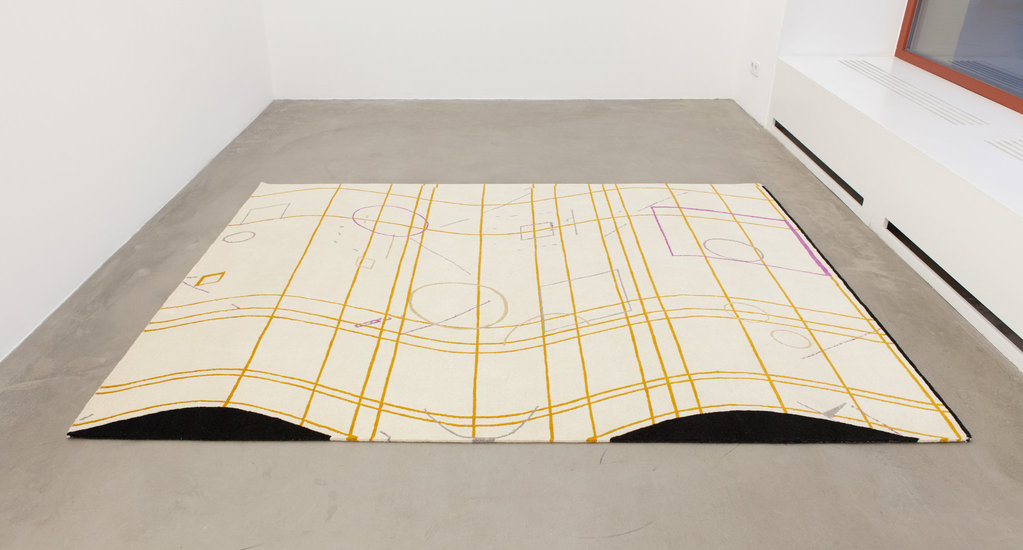 Submits (2012),
Submits (2012),  980(2013),
980(2013), 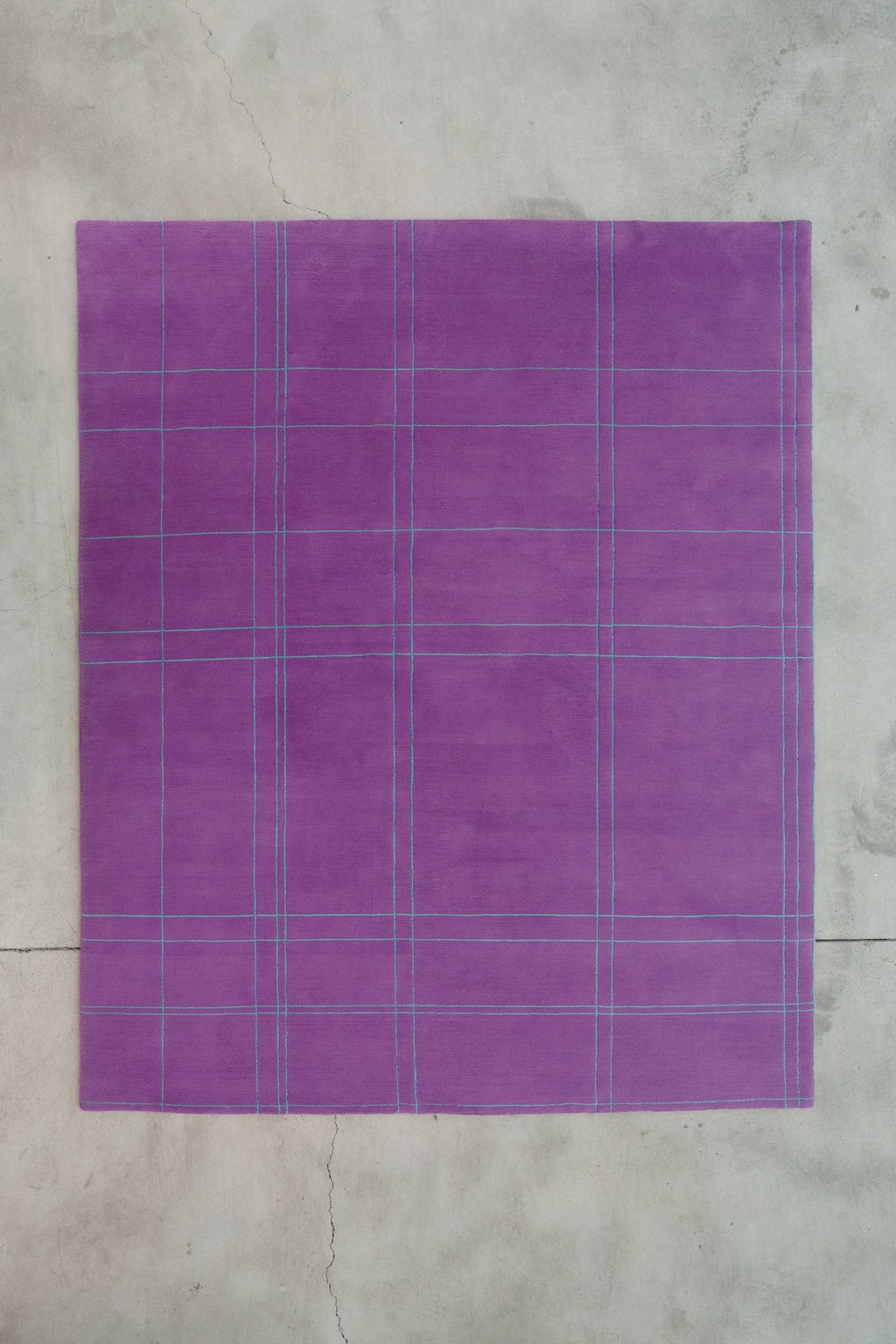 ineffectual (2013),
ineffectual (2013), 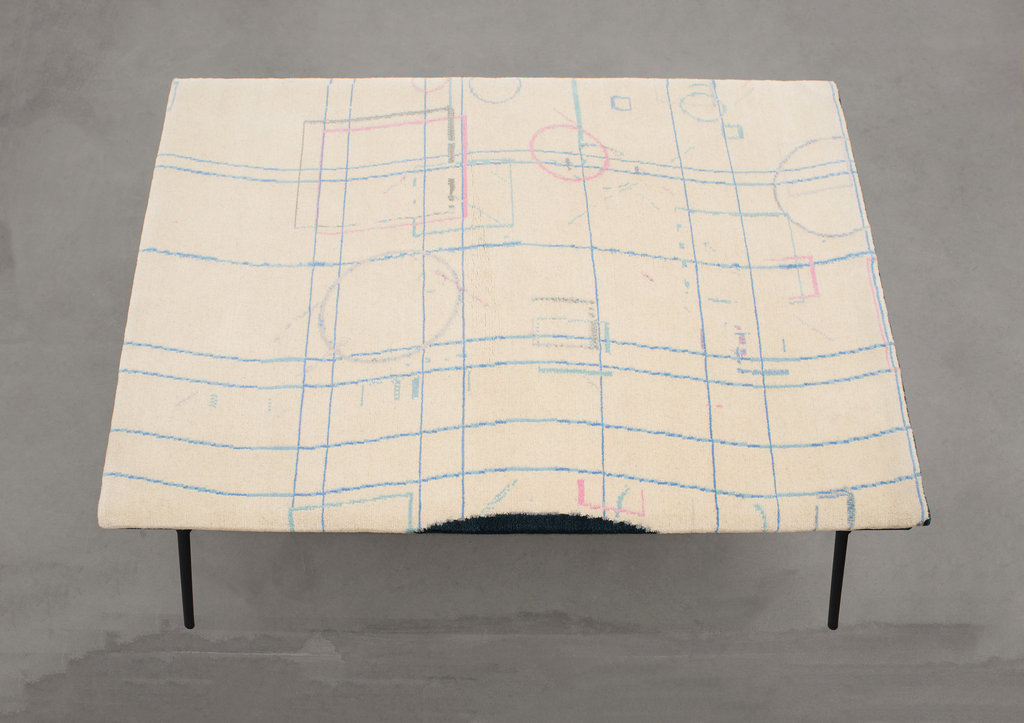 scalping (2013),
scalping (2013),  inviolable (2014),
inviolable (2014), 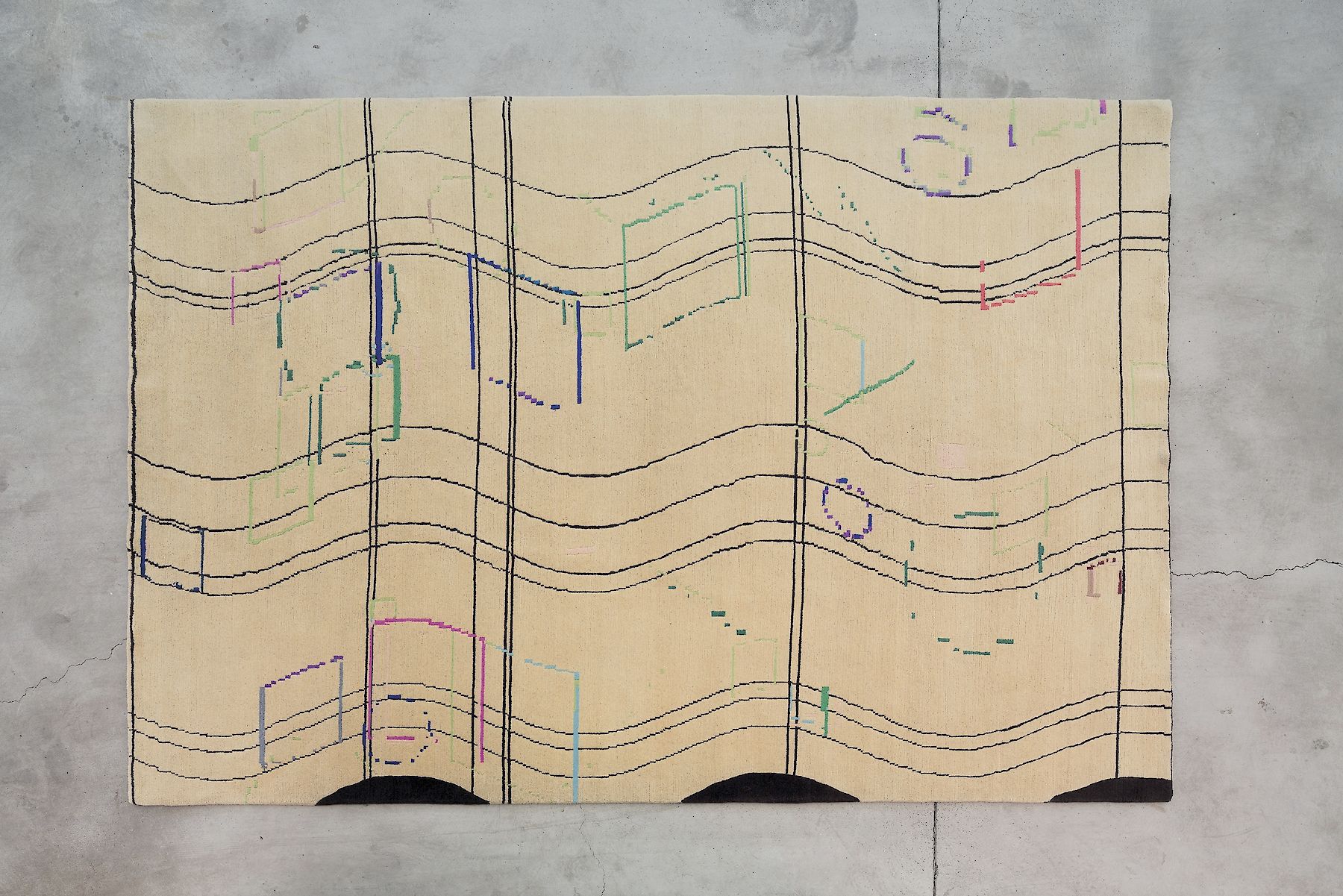 tackily(2014),
tackily(2014), 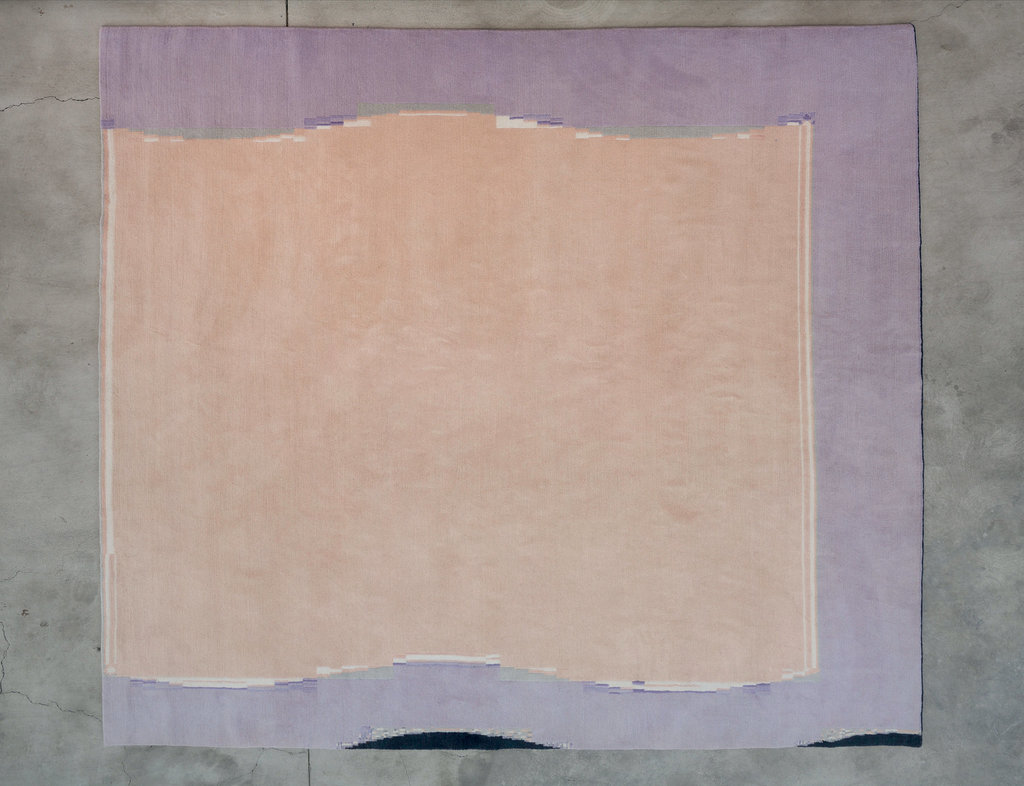 gladding (2014)
gladding (2014) 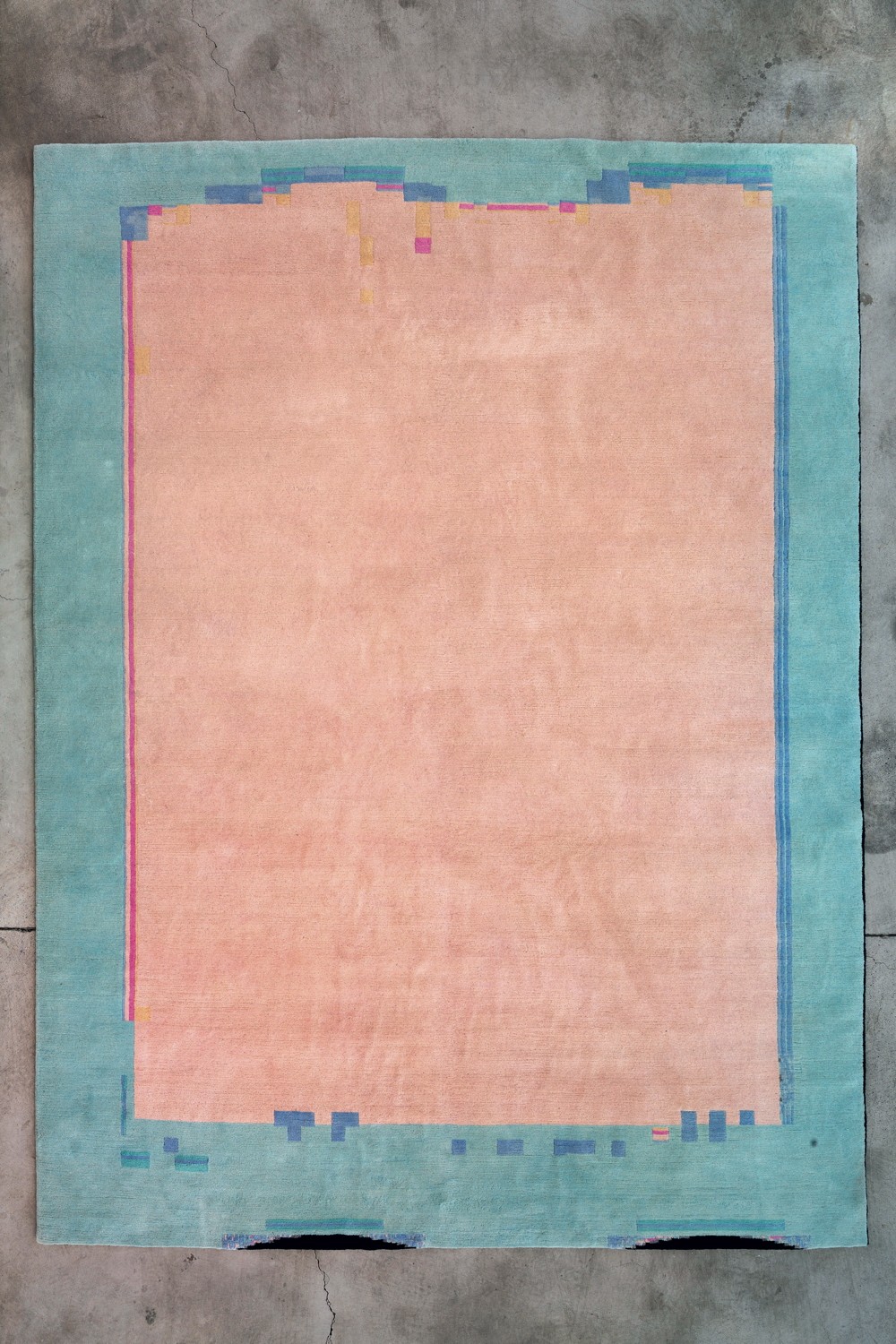 replicate the original subject headings of junk mails, the labels assigned to the jpegs of their files, or the graphics’ full names. Once turned into elegant, hand-tufted, and hand-knotted wool carpets, those images successfully make their way again into the intimacy of our private, domestic sphere, so that they can finally fulfill their initial goal. Boot closes the circle by explaining that he thinks “they are strongest when there are people living in the same space”—the quintessential stock image of the happy (post-digital) family.
replicate the original subject headings of junk mails, the labels assigned to the jpegs of their files, or the graphics’ full names. Once turned into elegant, hand-tufted, and hand-knotted wool carpets, those images successfully make their way again into the intimacy of our private, domestic sphere, so that they can finally fulfill their initial goal. Boot closes the circle by explaining that he thinks “they are strongest when there are people living in the same space”—the quintessential stock image of the happy (post-digital) family.While discussing the carpets, their conceptual framing, and their actual making (they are manufactured in Kathmandu, Nepal, from large Illustrator files sent by the artist, who discusses with the local producer the choice of colors on the basis of the standard Pantone palette), Boot pointed out to me a key reference from Michel Foucault’s “Des Espaces Autres” (Of Other Spaces, 1967) where he describes the carpet as a hortus conclusus, a paradisiac garden, as well as a heterotopia. “The garden is a rug onto which the whole world comes to enact its symbolic perfection, and the rug is a sort of garden that can move across space,” Foucault writes. In the same essay, the French author also remarks that “We are at a moment, I believe, when our experience of the world is less that of a long life developing through time than that of a network that connects points and intersects with its own skein.”
We call it the Web, nowadays, and Boot’s carpets mirror its experience. If the first Industrial Revolution had the loom as its totem, as the ideal tool for mass manufacturing textile goods at unprecedented speed, in the present time the keyboard and the touchpad have taken on the loom’s role as mass workbenches for manufacturing an endless flow of content, images, information, and data that informs the Web and our days. The contemporary notions of free time, of voluntary labor, and even of the “working classes” are still under (re)construction, like broken “threads.” And if, as Beatriz Colomina explained, our beds have become our offices, then the carpet is another perfectly comfortable item of domestic furniture where we can work 24/7.
Back in the 1960s, avant-garde groups such as Mono-ha and Arte Povera supported the idea of a “poor” art as a form of radical rejection of consumerism, its manic consumption pace, and the obsession for new, aptly fetishized media. It worked as an attempt to redeem old things annihilated by new technologies, as well as an attempt to “hack” them. “First came man, then the system. That is the way it used to be. Now it’s society that produces, and it’s man that consumes” was the incendiary incipit of the manifesto “Arte Povera: Notes for a Guerrilla War,” signed by Germano Celant and published in Flash Art in 1967. A current synonym for “poor” is “plain” or even “dumb,” as an intended opposition to “smart.” Very often Boot has used “poor” materials for his sculptural works, such as concrete, cheap wood, Euro-pallets, textiles, kitchen laminates, wax, fabricated or found metal sheets, raw linen, metal mesh, found cardboard, and even butcher paper, although the same works refer to the disembodied digital world, its languages, and its landscapes. There seems to be no opposition, nor rejection implied in his stance, and yet to “dumb down” what is supposedly immaterial and perennially in flux is another way to hammer at the rhetoric of the New Media. And when Boot resorts to traditional media, such as paint on canvas, to portray the digital worlds, for instance with the series of “Japanese/Google landscape paintings” (like Phillip Island,
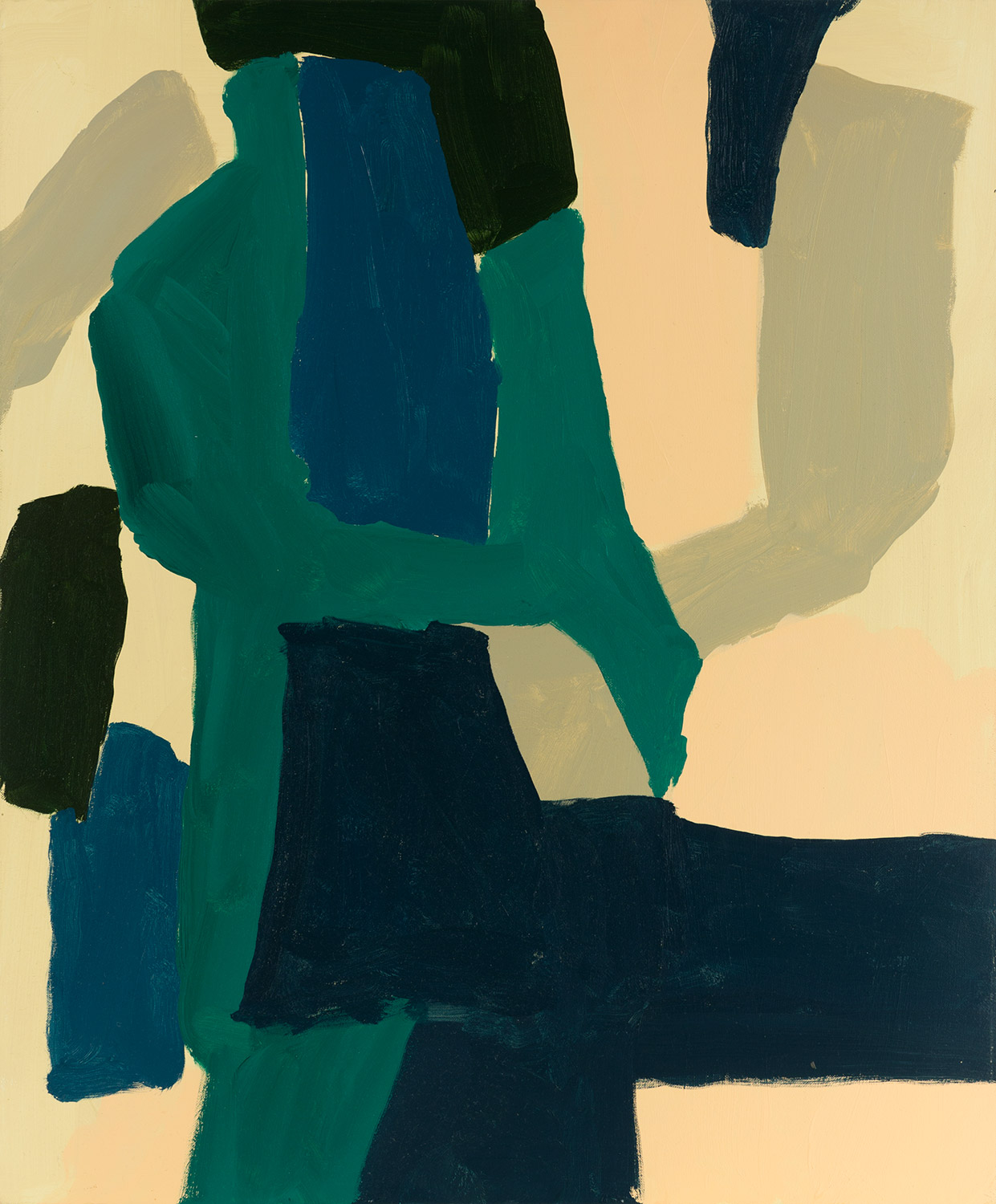 Raper Street,
Raper Street,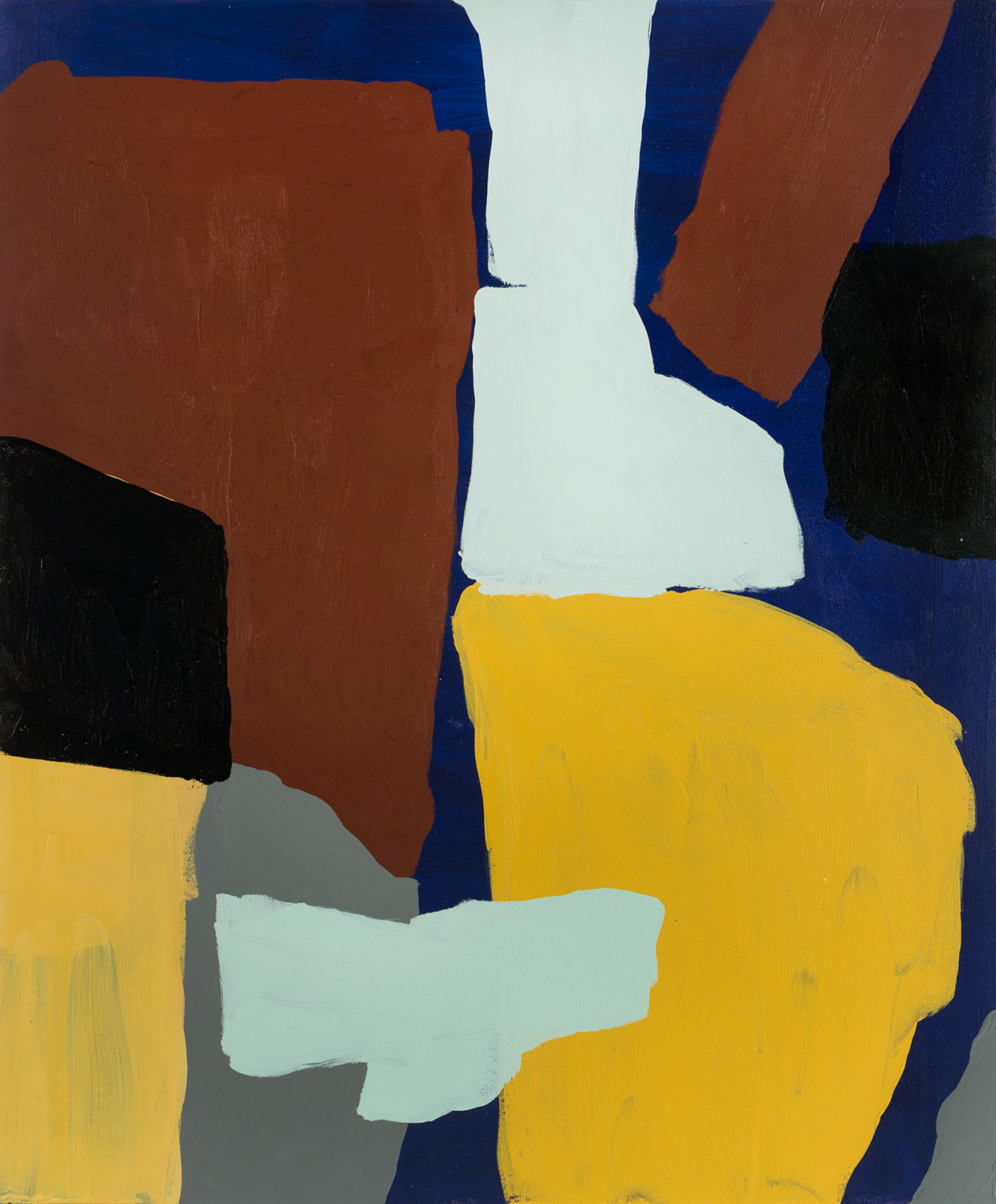 and Macleay Street,
and Macleay Street,  all 2016) his “Platz, platz” seems slightly more sardonic. “I first became aware of Japanese landscape painters by an interview of the Australian artist Brett Whiteley, whose use of color I’ve often found amazing. He discussed how some Japanese painters would paint the landscape by studying it in depth, by being present/ within/walking in the landscape, and only pick up a brush when they went back in the studio,” Boot says. “The color palette [of the Google landscape paintings] is inspired by Google image searches. While buffering, all images are reduced to a representative color, so that the palette is somewhat an archetype of the search—perhaps a good connection to how information is repeated within our collective (and varied) filter bubbles. By reproducing that palette, I am painting places where I have ‘walked.’ Colors are perceived subjectively and reflect our physical surroundings, but that’s not necessarily true for the digital sphere, elaborated by machines.” Painting here might be seen as a travelogue of the artist’s site visits and “walks,” slowed down to the point of stillness.
all 2016) his “Platz, platz” seems slightly more sardonic. “I first became aware of Japanese landscape painters by an interview of the Australian artist Brett Whiteley, whose use of color I’ve often found amazing. He discussed how some Japanese painters would paint the landscape by studying it in depth, by being present/ within/walking in the landscape, and only pick up a brush when they went back in the studio,” Boot says. “The color palette [of the Google landscape paintings] is inspired by Google image searches. While buffering, all images are reduced to a representative color, so that the palette is somewhat an archetype of the search—perhaps a good connection to how information is repeated within our collective (and varied) filter bubbles. By reproducing that palette, I am painting places where I have ‘walked.’ Colors are perceived subjectively and reflect our physical surroundings, but that’s not necessarily true for the digital sphere, elaborated by machines.” Painting here might be seen as a travelogue of the artist’s site visits and “walks,” slowed down to the point of stillness.In “Painting Beside Itself,” published in the journal October in the fall of 2009, David Joselit explains how “transitive painting ... invents forms and structures whose purpose is to demonstrate that once an object enters a network, it can never be fully stilled, but only subjected to different material states and speeds of circulation ranging from the geologically slow (cold storage) to the infinitely fast.” In a conversation with David Andrew Tasman, published on DIS Magazine (dismagazine.com) in March 2015, Joselit further clarifies his position:
The artwork almost always contains vestiges of what might be called the roots—or infrastructural extensions—of its entanglements in the world. These might include the means of production of the image, the human effort that brought it into being, its mode of circulation, the historical events that condition it, etc. The artwork’s format solidifies and makes visible that connective tissue, reinforcing the idea that the work of art encompasses both an image and its extensions. The term format does not merely distinguish between digital vs. analog, as medium might do, but points to how an image is situated within a set of relations that condition how efficacious it may be. Formats attract attention and exercise power. The difference between format and medium lies largely in the heterogeneity of the components—aesthetics, data, history, the scene of an action—which is anathema to traditional concepts of medium. When Bruno Latour talks about assemblages, he is talking about linkages—not the abstract infinity of a network. It’s difficult to quantify the limits of extension, for instance, one must think about what is folded into images as well as what extends out from them.
Boot works constantly on formats and circulation, as well as on possible ways of crossing the bridge between digital and analog art production. With fellow artist Valentin Ruhry, also based in Vienna, Boot operates the online platform cointemporary.com, which introduces to the public a selection of digital artworks, including editions—one at the time and for a limited amount of time—that can only be purchased in Bitcoin (MAK in Vienna acquired a piece, and it was the first museum to do so). Cointemporary has also facilitated discussions and meetings on topics such as digital information distribution and the blockchain, which is now one of Boot’s main interests. He’s been designing new 3-D modeled “smart” sculptures as well as the distribution of their digital files via blockchain, so that the same work can exist and travel IRL as well as online. “The structure of the blockchain allows for a decentralized exchange. I am particularly interested in Ethereum-based cryptocurrencies and their varied use cases. I read a good analogy: that Bitcoin is the coin, and Ethereum is the hammer. With Ethereum complex projects can be built . . . and the Internet will morph into something completely different (no idea what that will be),” he told me.
Art and market spend a lot of time in bed together lately, while algorithms work feverishly at the construction of art value, artists’ rankings, celebrity status, and augmented visibility. Blockchain is a new digital infrastructure, built with “solid blocks”— architectural metaphors back in play—that are bound to impact the physical world, and especially the space of our lived environment because of the Internet of things. The blockchain’s promise of absolute traceability and permanent resistance against the alteration or destruction of data should be granted by decentralized consensus and the absence of a centralized server. Its perceived utopia (or potential dystopia, according to other views) also reminds us, I think, that the digital “environments” that we’ve built so far are not really open, nor really public, and that we’re not always free to choose or to control what circulates in them, let alone what images—while the movements of people and bodies across borders and countries, on the other hand, are increasingly monitored, filtered, and controlled. Let’s hope that we’re not really ready to sit down and obey just yet.